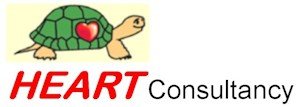Moscow, Sheremetyevo Airport 09-04-2013
Dear all,
It’s almost over again! I’m waiting at gate 40 of Moscow’s airport Sheremetyevo. On Monday evening April 1st I arrived safely here and was received by Mrs. Elena, the lady with whom I was in touch during the past two years on the Russian translation of the book on sterilisation.
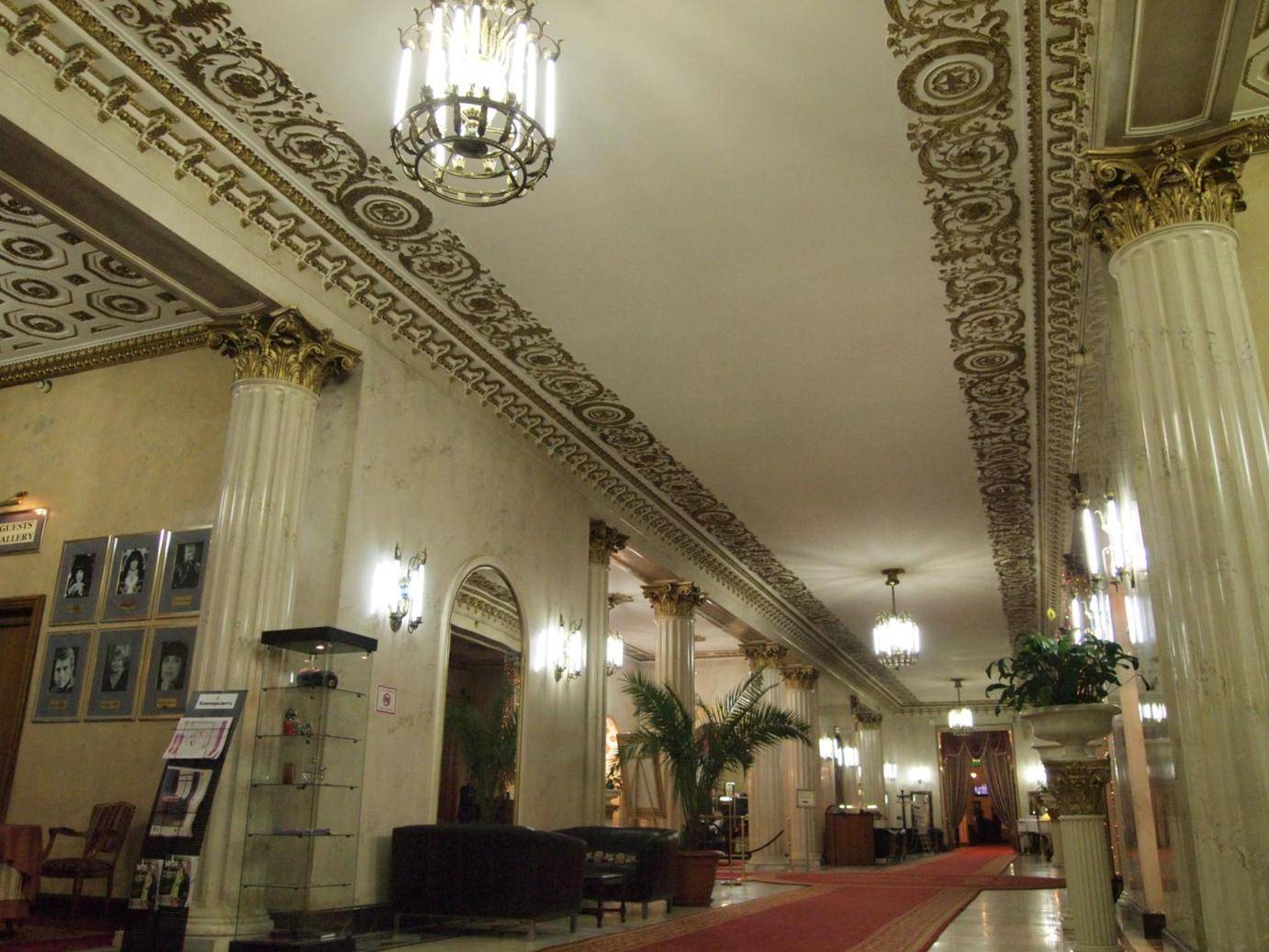 |
Elena works as the product manager for Pharmstandard/DGM, on of the largest manufactures of sterilization equipment and supplier of related products for the Central Sterilization Department of hospitals. She is a very charming, enthusiastic lady who really goes for it! Moscow, there I am, suddenly in this chic hotel Sovietsky (Photo1) that still breathes the atmosphere of Soviet times. With real paintings of Breznjev, Lenin and other great leaders. A hotel that was visited by some of the great people of this earth: Margeret Thatcher (she died recently), Lenonid Breznjef, Pierre Cardin, etc. It’s really very special that I can stay in such a historical place! |
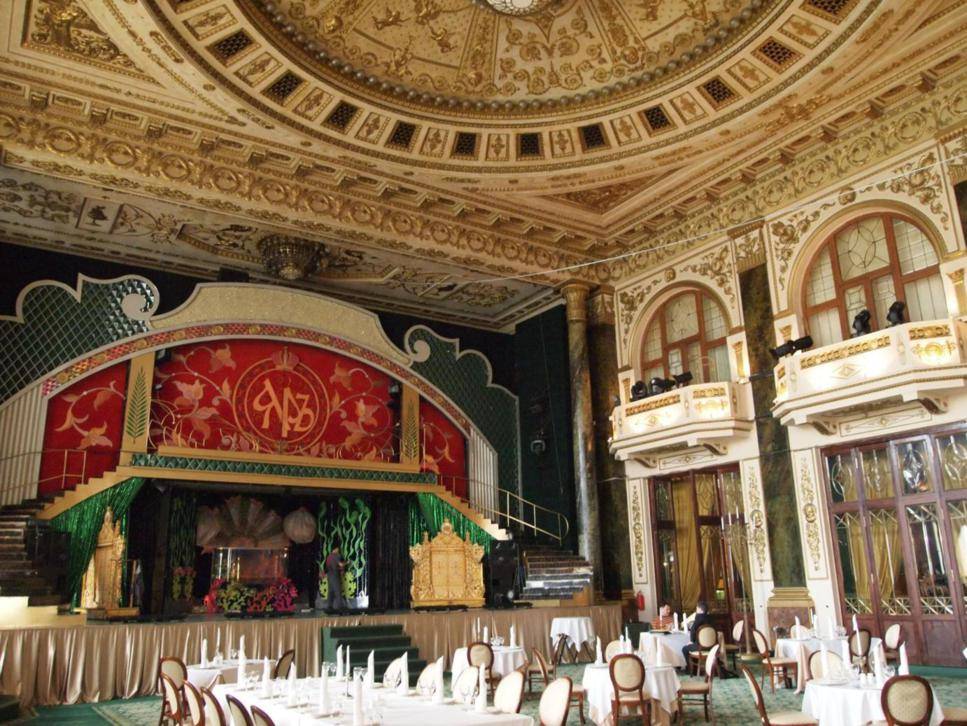 Together with Elena I take dinner and discuss the plans for the coming days. While enjoying Borsch, a Russian soup with red beets.
Together with Elena I take dinner and discuss the plans for the coming days. While enjoying Borsch, a Russian soup with red beets.
Followed by a main dish with a kind of minced-meat dumplings: A dinner in an atmosphere where even the Tsar of Russia would have felt at ease. With life piano music in the background, under chandeliers; the magnificent ceiling and of course an excellent dinner! (Photo 2)
Visit to the company Pharmstandard/DGM
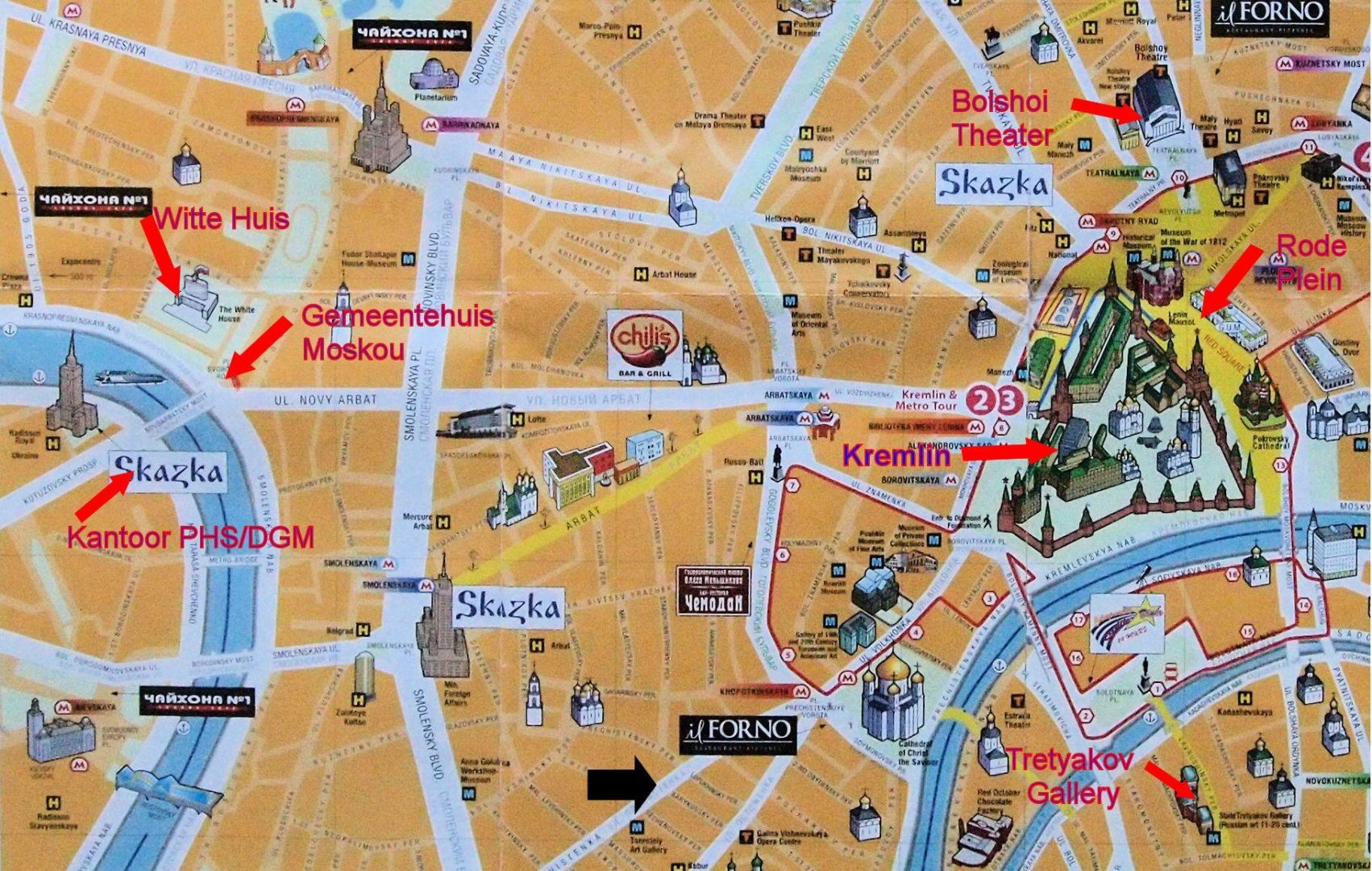 |
The following morning Arthur, the taxi driver, collects me for the first meetings in the office of Pharmstandard/DGM, the company that invited me. The offices are located virtually in the centre of the city. |
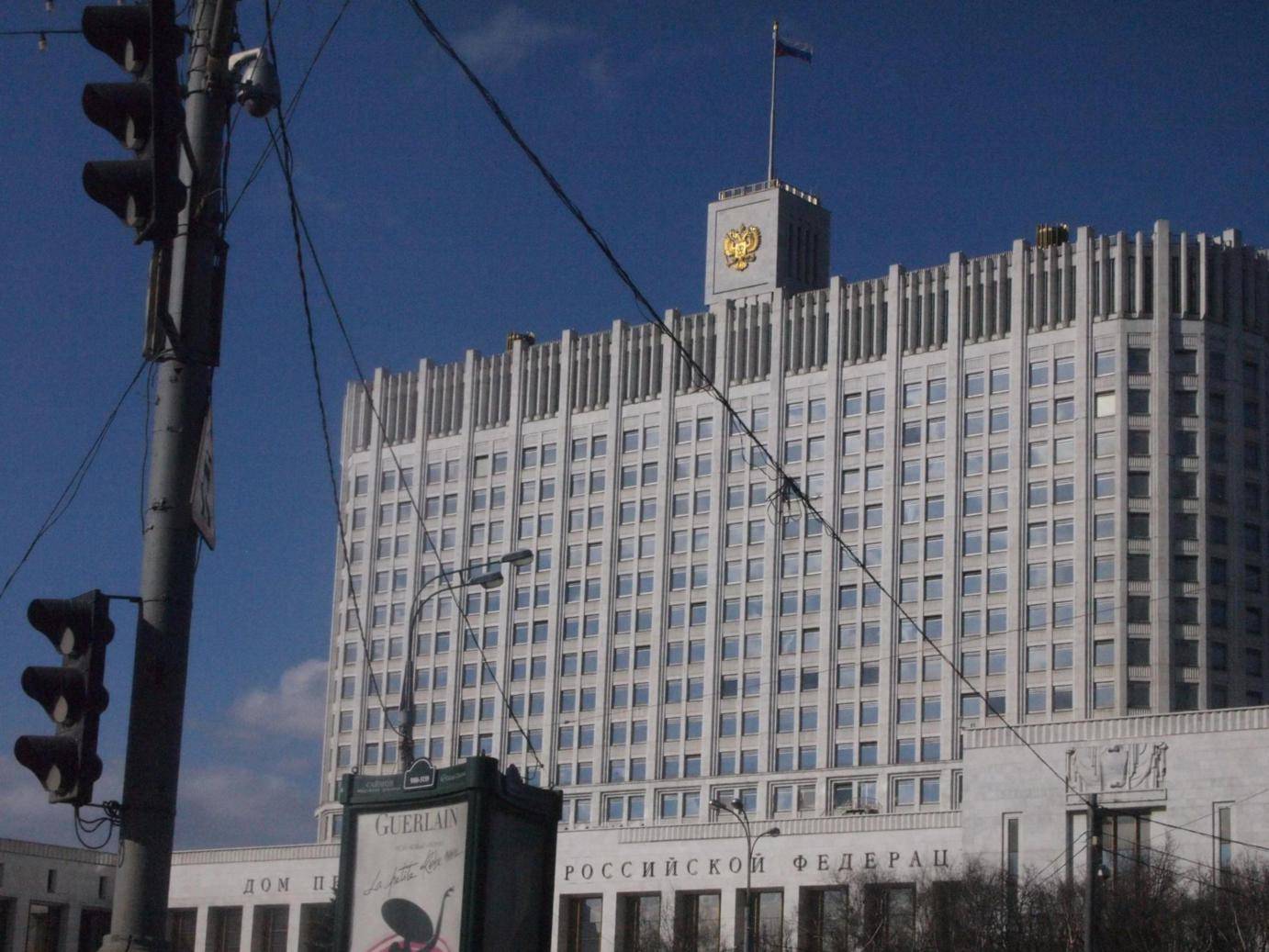 |
On the way the famous White House appears (on the left of the map on Photo 3), currently it is the Russian Government’s building. Under the regime of Boris Jeltsin, in 1993, during the big constitutional crisis, this – at the time parliament building – was shelled by artillery fire (Photo 4).Unbelievable what has happened here! It is cold! Along the side the roads there are still mountains of snow: memories of a long, cold winter. Also here people really are longing for spring! |
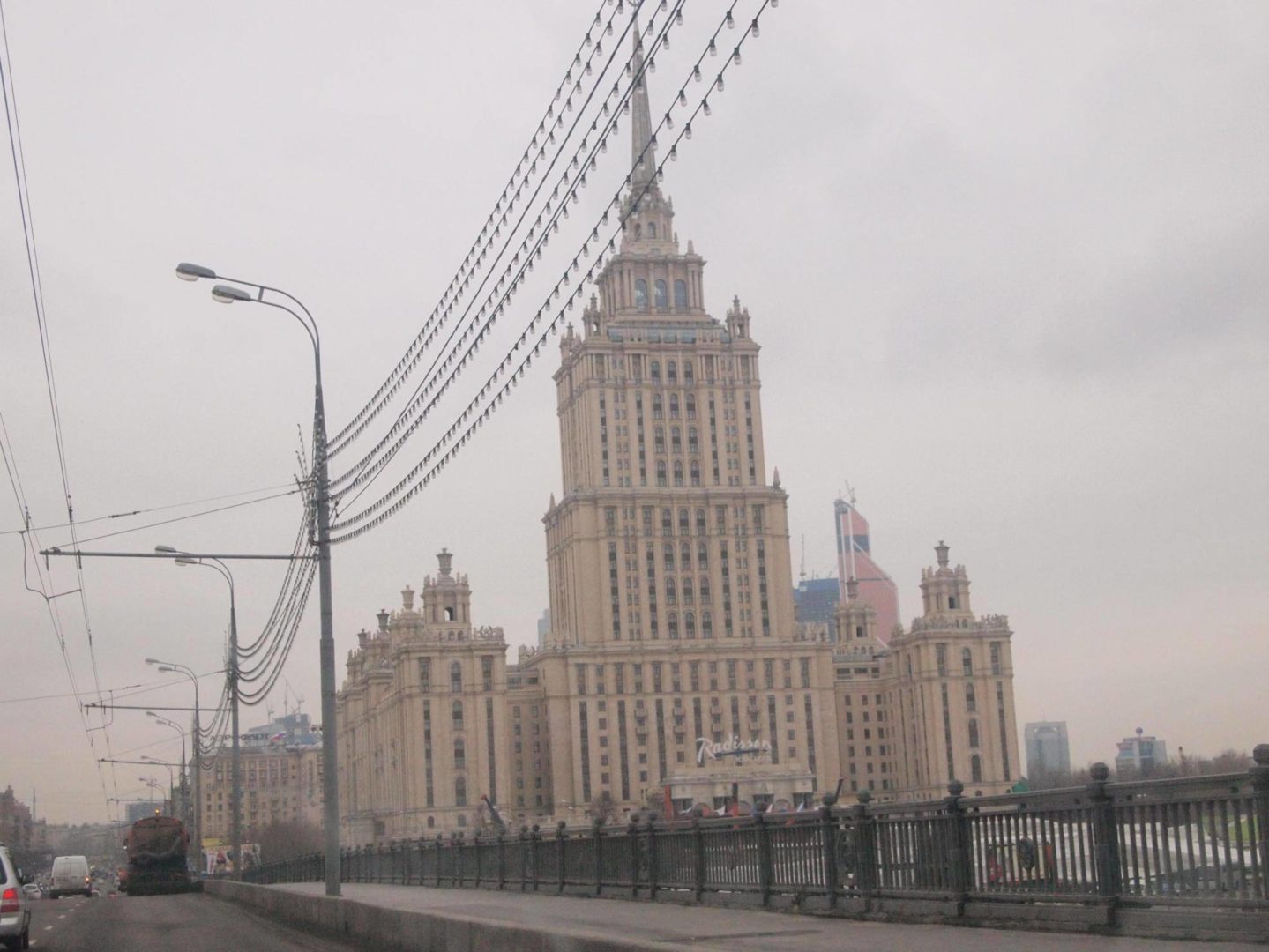 |
From the office one of the 7 characteristic skyscrapers can be seen; they were built on the command of Stalin in the period of 1947-1953. Wherever you are in Moscow, if you look around a bit, you will see one of these colossuses with the so characteristic pointed tower and the red star on top (Photo 5) |
The office is situated in a renovated, old Soviet-time brewery building (Photo 6). The morning starts with an introduction to the company and its’ activities. Then it is my turn. With 3 presentations: About standards related to sterile supply, my experiences in Africa and a virtual tour through the CSSD of the hospital in Ede (in The Netherlands, near the village I live).
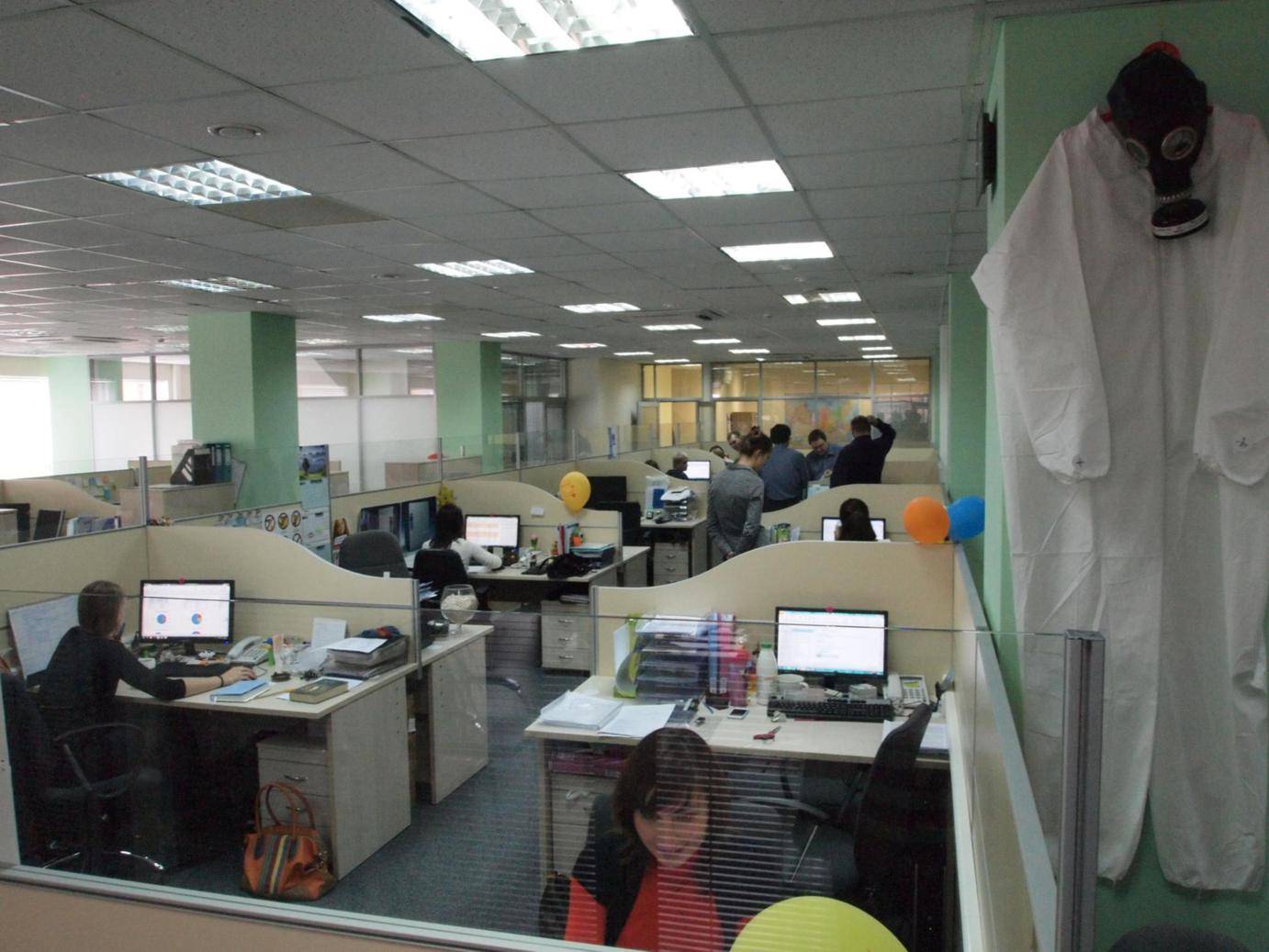
At the end of the day in the hotel a dinner with Elena, Vladimir (head project management) and Petr. Petr is head of the CSSD of hospital Nr. 4. Very sober! Hospitals have no name; they have to cope with a number. Petr is considered an authority on sterilisation in Russia. Really great that I have a chance to exchange ideas with this group of people! That evening in the hotel at work to prepare the presentation for the congress that is scheduled on Thursday April 4th. The congress takes place in the Moscow municipality building! It is located near the White House (seat of the Russian Government). I only have 30 minutes, including translation! In that short time I need to convey my message! My head is dizzy. What for God’s sake I should tell in 15 minutes? Finally we choose for the central theme: the need of education: the presentation of the book fits into this topic seamlessly. The next day we worked out the presentation; together with Elena and Ekatarina; Ekaterina will do the translation during the presentation.
Sterilisation congress
On Thursday then to the tower of the Moscow municipality. Lots of security. However without problems we get in. Bizarre: in the building is an exhibition of outdoor products. With the emphasis on knives. In all shapes and sizes. First you need to pass extensive security checks in order to get in and subsequently one ends up in an exhibition with gruesome knives and daggers.
 On the floor higher-up are the booths of the companies for our sterilization congress: with sterilizers, control materials, packaging materials, etc. Where also PHS/DGM has its booth. A warm encounter! Everybody is ready for it. People stroll in between the stands. The congress hall: that huge theatre! With on the sides of the large stage paintings with Orthodox-Russian scenes. The for me intimidating pulpit with 4 microphones and alongside the presidium with the large leather armchairs for the congress panel. Help! It’s here where I will be standing in a few moments from now!
On the floor higher-up are the booths of the companies for our sterilization congress: with sterilizers, control materials, packaging materials, etc. Where also PHS/DGM has its booth. A warm encounter! Everybody is ready for it. People stroll in between the stands. The congress hall: that huge theatre! With on the sides of the large stage paintings with Orthodox-Russian scenes. The for me intimidating pulpit with 4 microphones and alongside the presidium with the large leather armchairs for the congress panel. Help! It’s here where I will be standing in a few moments from now!
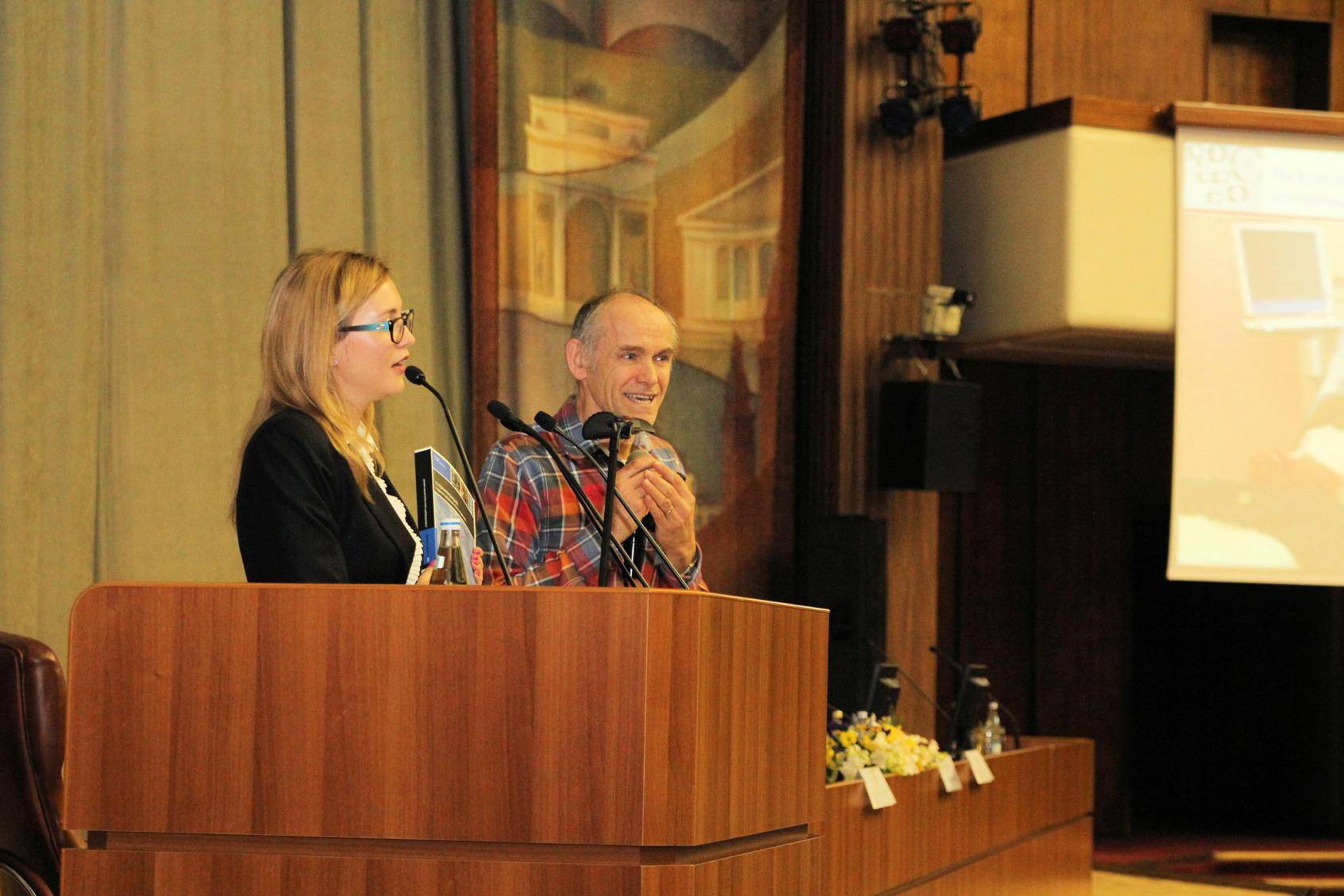 The opening of the congress is by the highest responsible for infection prevention of the Russian Ministry of Health. State awards are presented. Also the director of “our” company, PHS/DGM gets an award for the groundbreaking work related to infection prevention. I am the 4th speaker. Mr. Dimitri, manager of DGM introduces the activities of the company. Then it’s my turn. I feel the increasing tension inside myself. A kind of feverish feeling. The hall is filled about 2/3rds. Ekitarina takes her position behind the pulpit (Photo 08). I feel terrible to stand there. After some negotiating I received a wireless microphone, which gives me some freedom to move around (Photo 9).
The opening of the congress is by the highest responsible for infection prevention of the Russian Ministry of Health. State awards are presented. Also the director of “our” company, PHS/DGM gets an award for the groundbreaking work related to infection prevention. I am the 4th speaker. Mr. Dimitri, manager of DGM introduces the activities of the company. Then it’s my turn. I feel the increasing tension inside myself. A kind of feverish feeling. The hall is filled about 2/3rds. Ekitarina takes her position behind the pulpit (Photo 08). I feel terrible to stand there. After some negotiating I received a wireless microphone, which gives me some freedom to move around (Photo 9).
First a short history of the last decennia of sterilization in the he Netherlands and Europe. The deadly accident due to non-sterile intravenous fluids in a Dutch Hospital as the trigger for regulations. The European unification, the coming into being of European cooperation related to sterilization. The first standards. The pioneering role that The Netherlands had in this. A look into the CSSD of a Dutch Hospital (Ede). The introduction of ever new and ever more complex instruments. The need for quality assurance; in all steps of the sterile supply cycle. With as an important key: Education. Through education the link to the book is made easily. Here I am, in front of a public coming from large parts of Russia. In the Moscow Municipality hall. I have a chance to be here. I am allowed to contribute. Feel very much honoured! And thank everybody who was involved in the realization of the book. I thank for the invitation for coming here. Ekaterina does really a great job. Is a very nice feeling presenting something in this way as a very close team!ational Gallary of Russia. I get to know the Russian masters: Vroebel, Surikov, Repin. The essence of Russia. The enormous sufferering of the people here. The beauty of the land. Emotions have been documentented. Such as the painting called The Demon, painted by Vroebel (1856-1910). What a power! The sitting rugged appearance; the emotion of evil; but also the sadness, the pain, the tear under his right eye. The female touch (Photo 10). Or the intriguing painting of the arrest of Morozova, accused of heresy during the reformation of the Russian Orthodox Church (1675). The church penetrated everywhere in society. The split-up of society based on religious convictions: An issue that is still marking tragic major events and developments upto today.

The tension fades away from me. Its over. It went OK. With Olga and Sacha, both employees of the company, we now go into the city. To the Tretyakov Gallery. The National Gallary of Russia. I get to know the Russian masters: Vroebel, Surikov, Repin. The essence of Russia. The enormous sufferering of the people here. The beauty of the land. Emotions have been documentented. Such as the painting called The Demon, painted by Vroebel (1856-1910). What a power! The sitting rugged appearance; the emotion of evil; but also the sadness, the pain, the tear under his right eye. The female touch (Photo 10). Or the intriguing painting of the arrest of Morozova, accused of heresy during the reformation of the Russian Orthodox Church (1675). The church penetrated everywhere in society. The split-up of society based on religious convictions: An issue that is still marking tragic major events and developments upto today.
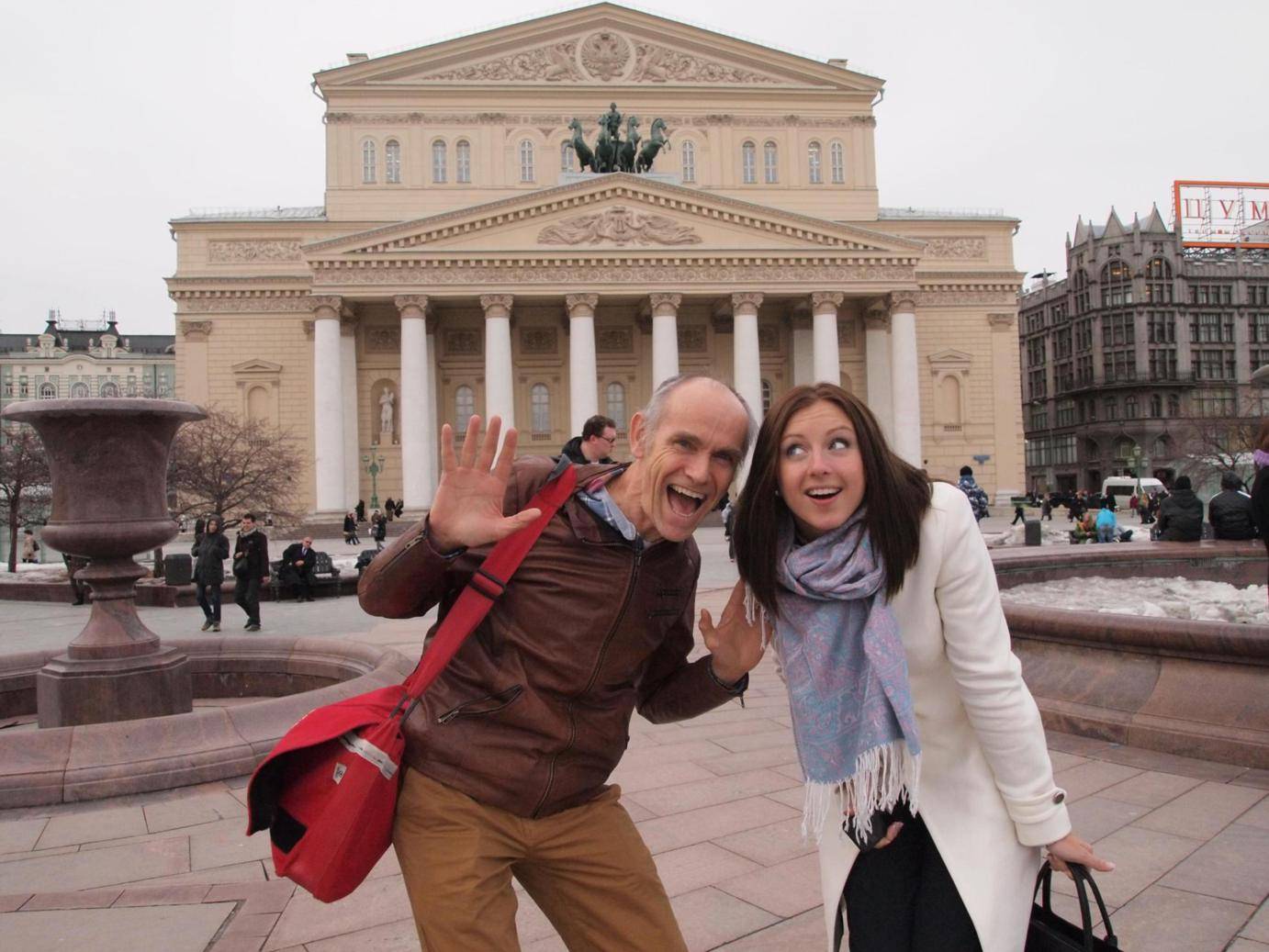
We walk to the Boshoi Theatre, a bit further on (Photo 11). Built at the occasion of the coronation of Alexander II in 1856. We can attend an opera of the Italian composer Verdi: the Traviata (the Wanderer; in 1853 it had its first performance). Here in the largest cultural temple of Russia. It is the 1752nd edition and the 237rd season(!). We go inside. Grand baroque halls. The building just has been renovated. The glitter of gold; the chandeliers with the splendour of their crystals. Large paintings. And then the theatre itself. Fully in style. We have a very good view on the stage. The golden ornaments. The red velvet. The whole entourage of luxury of the high society of old-Russia.
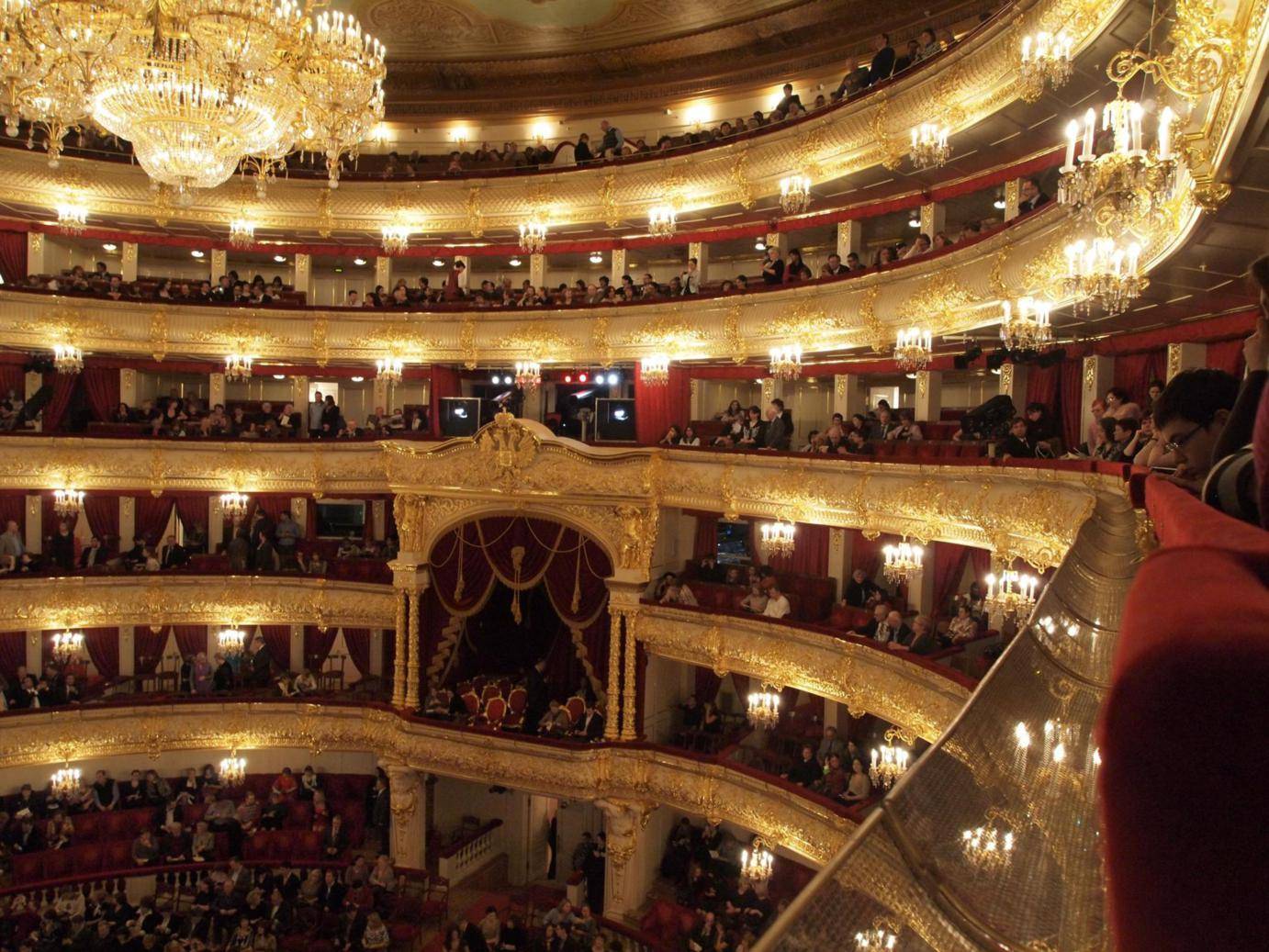 |
It breathes the atmosphere, the allure. Verdi’s opera is about, what else could it be, the tragedy of love. The drama, the emotion of relations, intrigues, families, sickness and finally the death of the lady, due to tuberculosis. Followed by the grief of the belover. A performance with ever changing backgrounds. It became an overwhelming cultural evening! |
| The cityscene. Heavy traffic as in every large city. Maintenance on the roads is crucial. The tough cold Russian winters demand their toll. In convoy large trucks with high pressure water guns clean the streets. The greyish urban areas. On several buildings there are still large paintings that remind to the Soviet times. The stereotypes of the ideal socialistic society. (Photo 13: written: Together we make communism). We pass the statue of the proud farmer and his wife with their hammer and sickle. A bit outside the old city centre a new business centre is whipped up. Futuristic skyscrapers will dwarf the old Stalin buildings in the city skyline. |
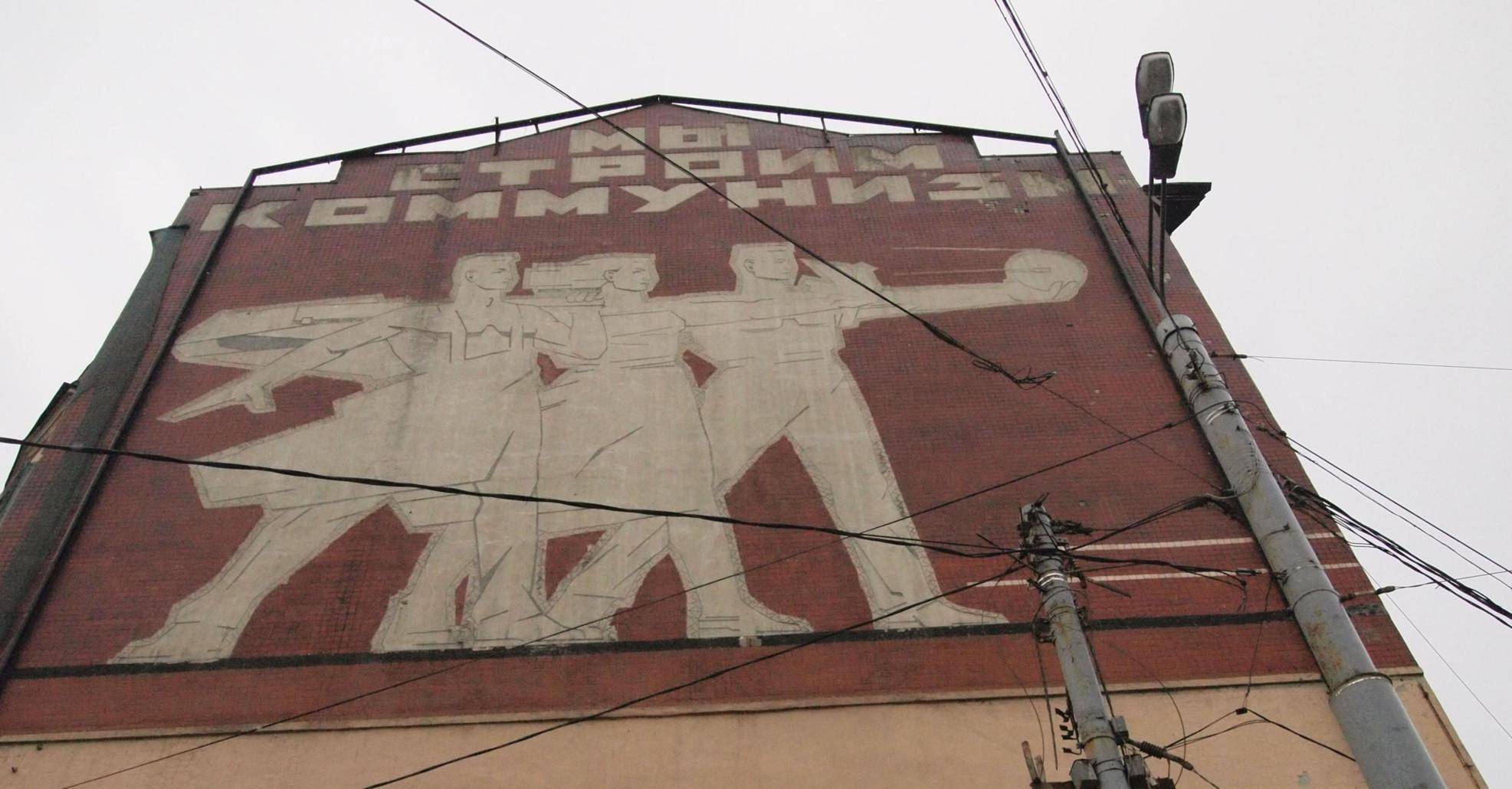 |
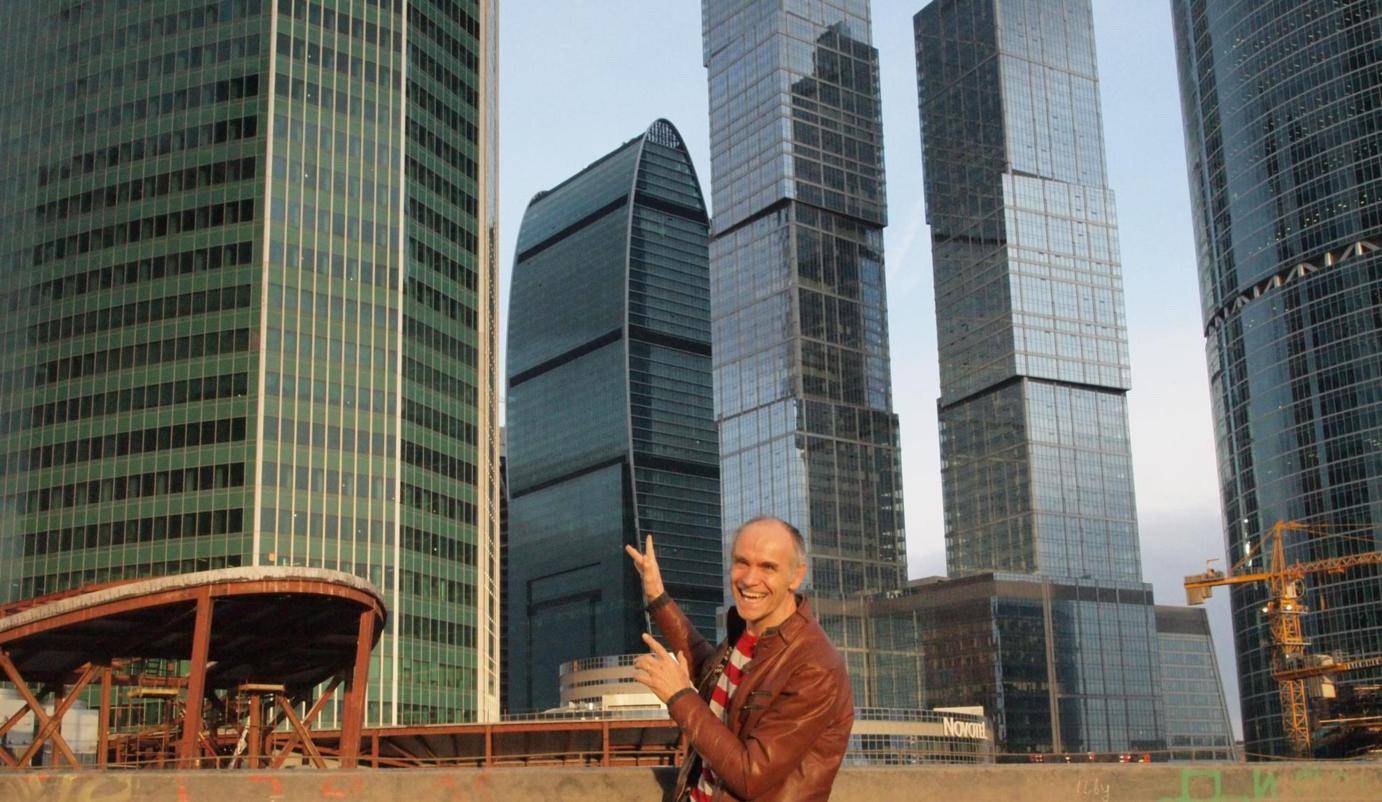 |
 |
Epicentre of Russia: the Red Square
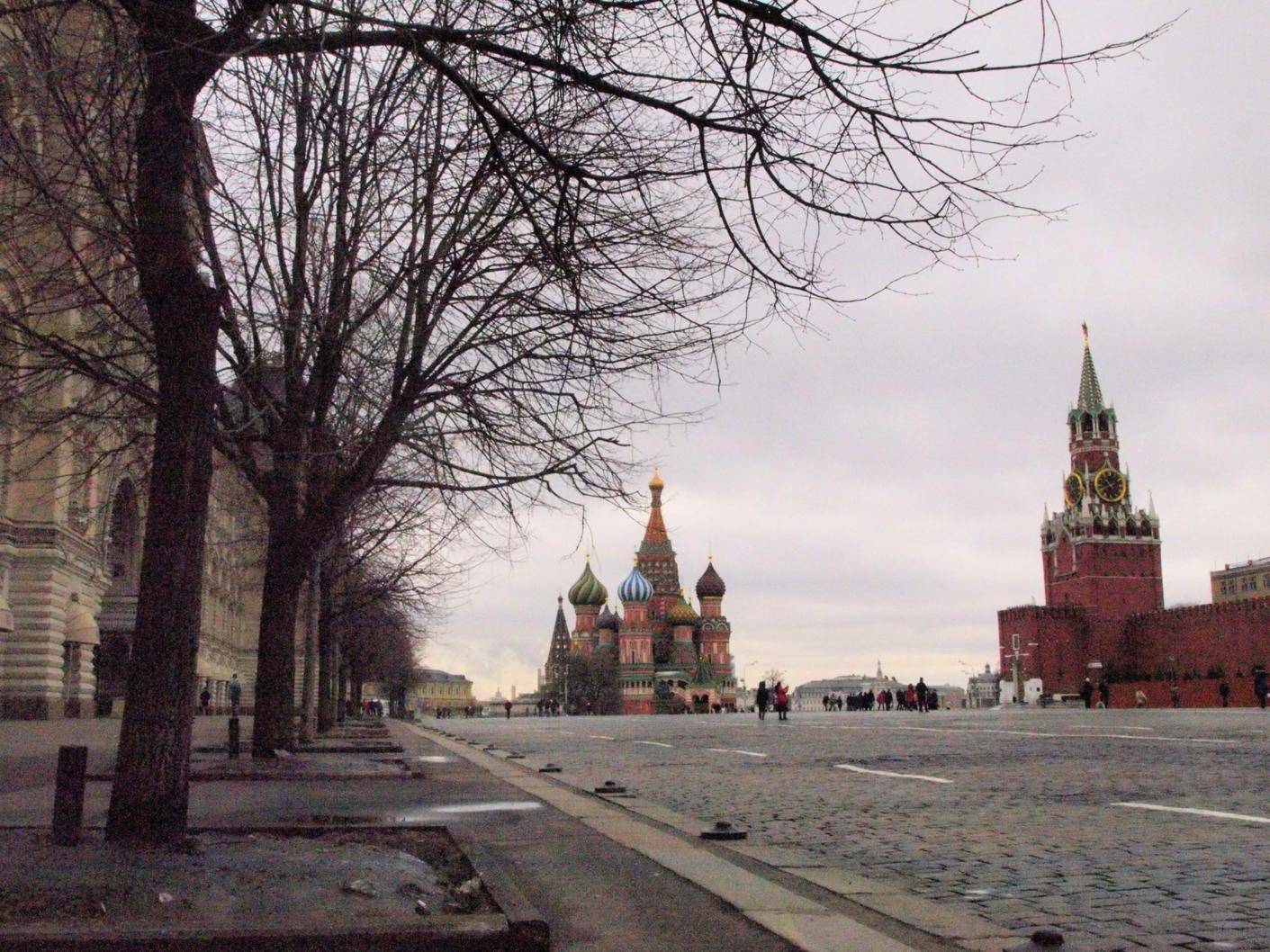
The weekend: Olga, employee of DGM, collects me already at 9 am in the hotel. To the city centre. Moscow, as is Amsterdam, is built in concentric circels. With the Kremlin and the Red Square as its centre. It’s coooooollldddd. We take a coffee in the Mac Donalds, with a view on the Kremlin wall. It was opened during the period of Glasnost (openness) and Perestroyka (restructuring) in Gorbachov’s time (nineties of the previous century). It became a symbol of great changes in Soviet Russia. We also meet Sacha, the PR-person of DGM; we cross to the entrance of the Red Square. The huge square stretches out in front of us (Photo 15). On the right the wall and towers of the Kremlin. In front of the wall the Mausoleum of Lenin, now hidden under a huge white inflated hall; it is being renovated.
| Right in front of me in the distance the Cathedral of Prokrovsky, of which the colourful domes resemble the shape of a soft ice. The cathedral was built upon the order of Ivan the Terrible and was inaugurated in 1561.Olga Tells. Our guide (Photo 16) The whole scene reminds me of song of Gilbert Becaud: Natalie: la Place Rouge…. This feeling expressed so powerful in this song. On the left a large shopping mall in old Russian style. The police is present on the background. It’s quiet on the square. The cold wind cuts in the face. It really feels like Russia. Olga points at the execution place, just in front of the cathedral. Here decrees were read and people were executed. Churches and executions: intensely intertwined. |
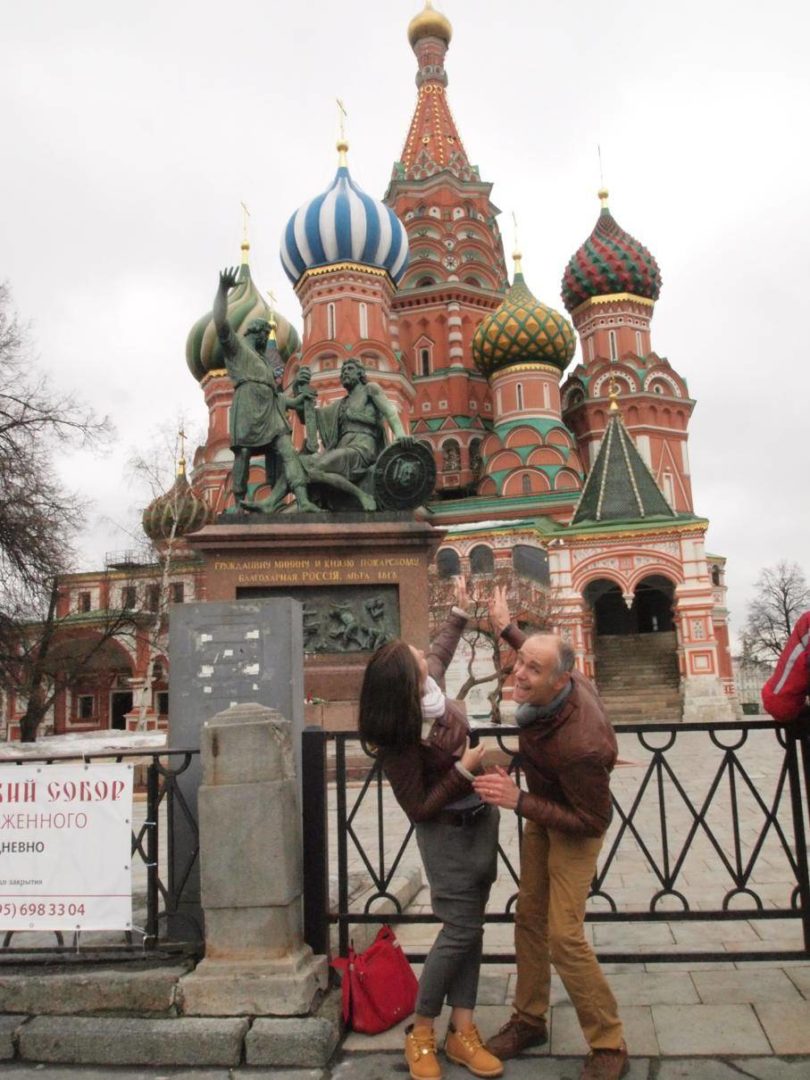 |
| That cathedral: highlight of Russian religion, art and culture (Photo 16). The National symbol in which everything Russian seems coming together. National icon. Inside are the fantastic frescos in the so typical style of the Russian-Orthodox church. Gold in abundance everywhere. It reflects the great beauty and splendour the church wanted to convey (Photo 17). |
 |
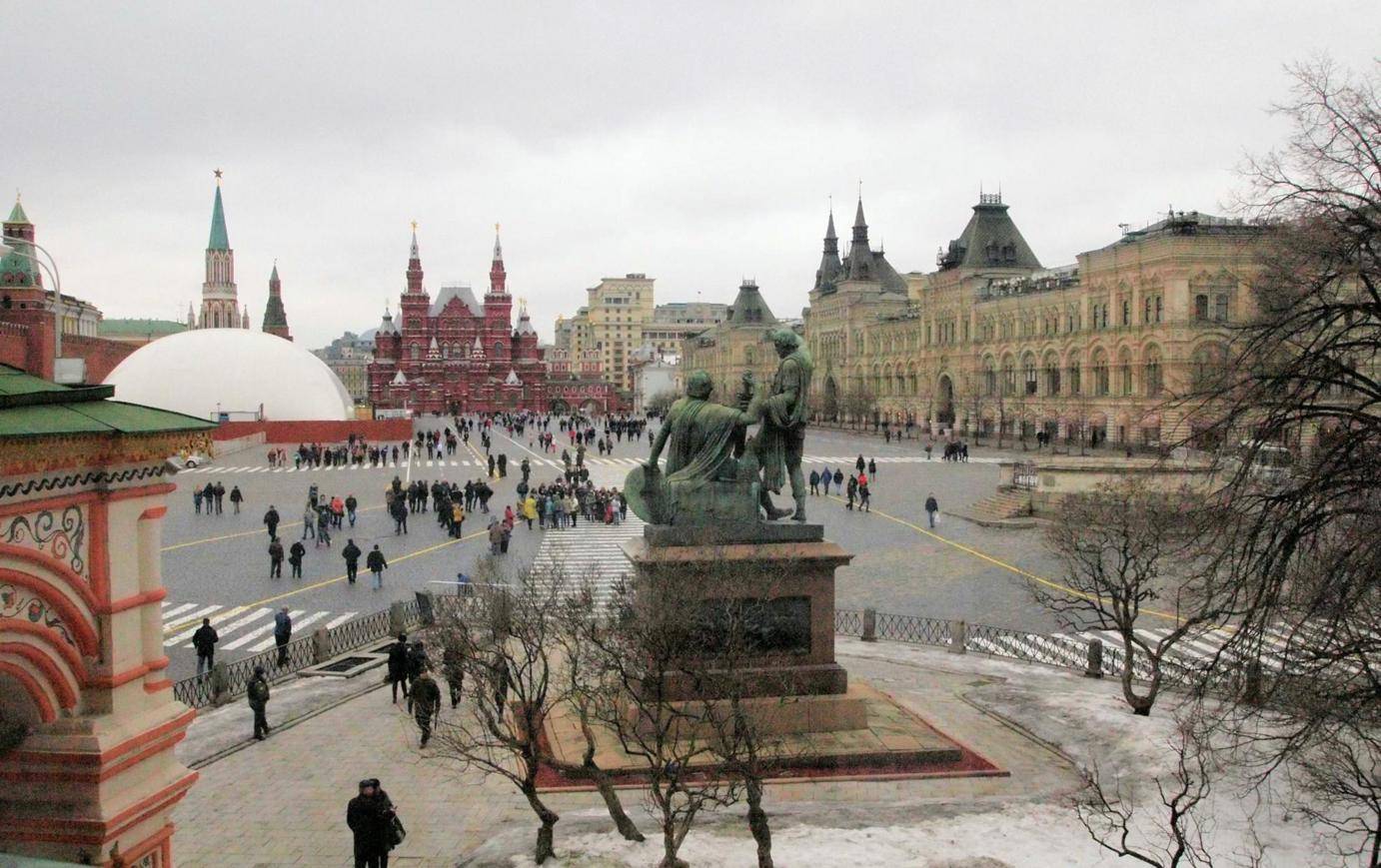 |
From one of the towers we have a fantastic view onto the square (Photo 19). Olga tells about Ivan the Terrible, who killed his son. About Peter the Great. About Lenin’s October revolution of 1917; the time of the cold war. Gorbachov, who made an end to the old Soviet time. Oh, my brain is whirling. So much has happened here. So much grief, so much history was made here! |
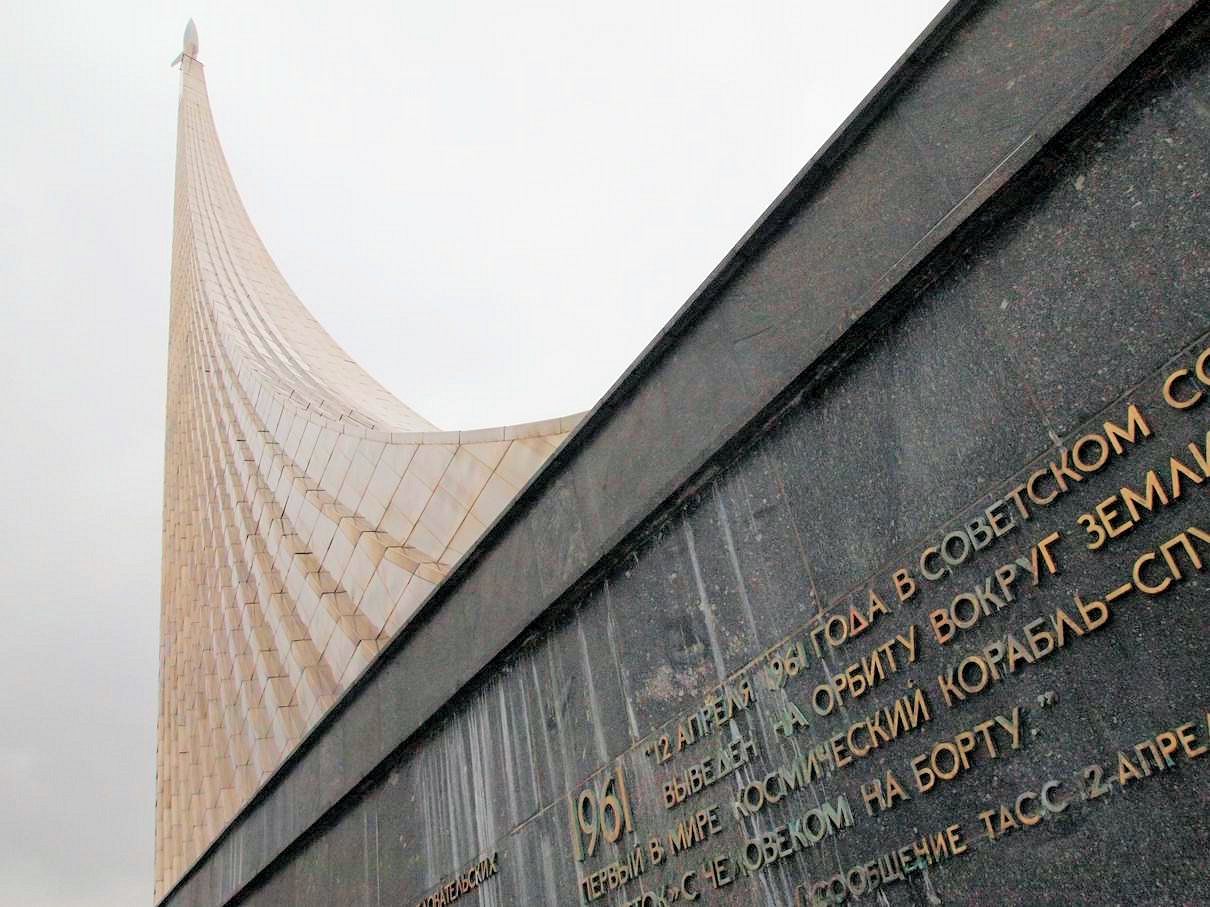 |
In the afternoon a boys’ dream comes true: a visit to the Space Travel Memorial Centre! (Photo 19). Where everything is shown about Russian space travel. The early developments, the launch of the first Sputnik in 1957 (Photo 20), the race for space between Russia and the USA. Yuri Gagarin, in 1961 the first man in space, absolute hero of the Soviet era. Visitors are mainly school children. Russia wants to transfer some of the great excitement of the era that mankind, for the first time, left its planet. And of course it also nurtures national pride (Photo 21) |
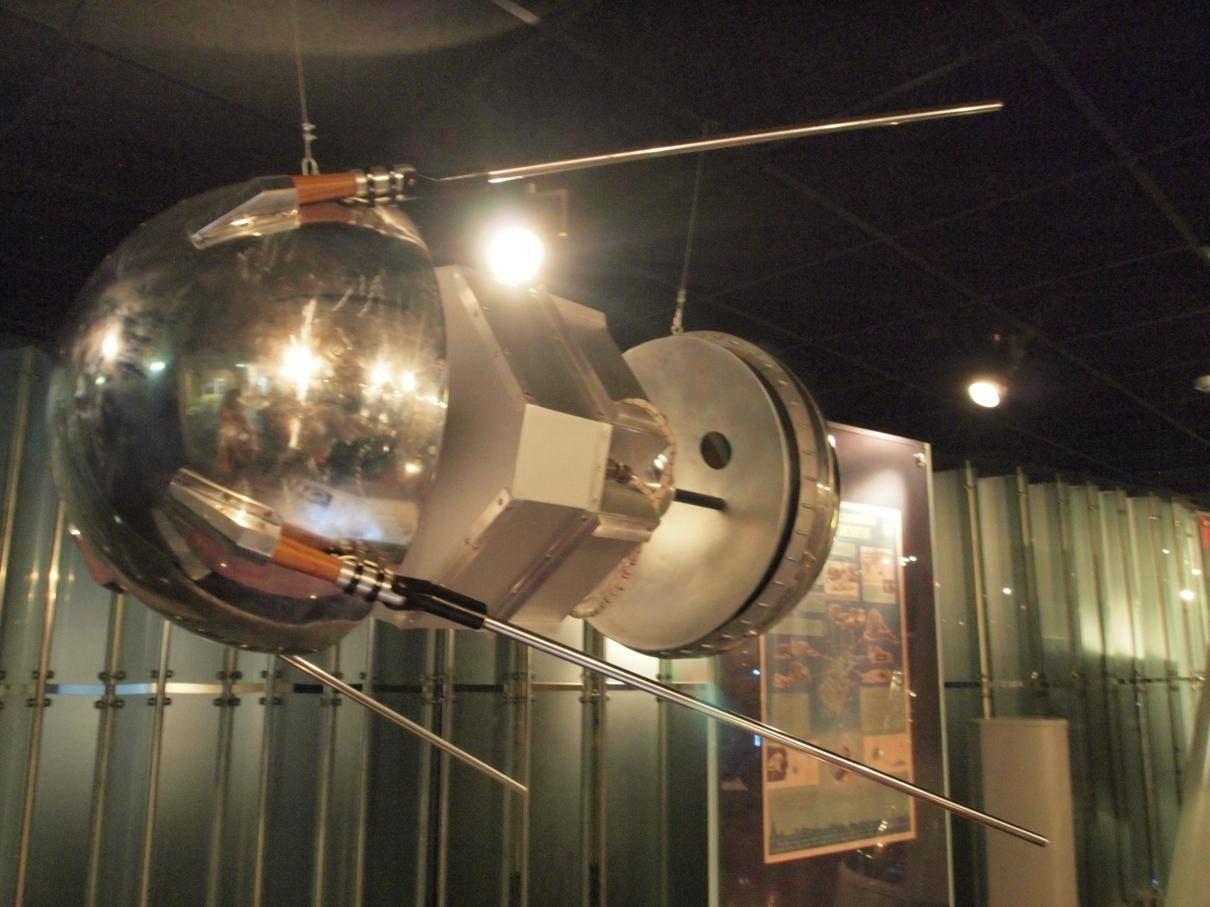 |
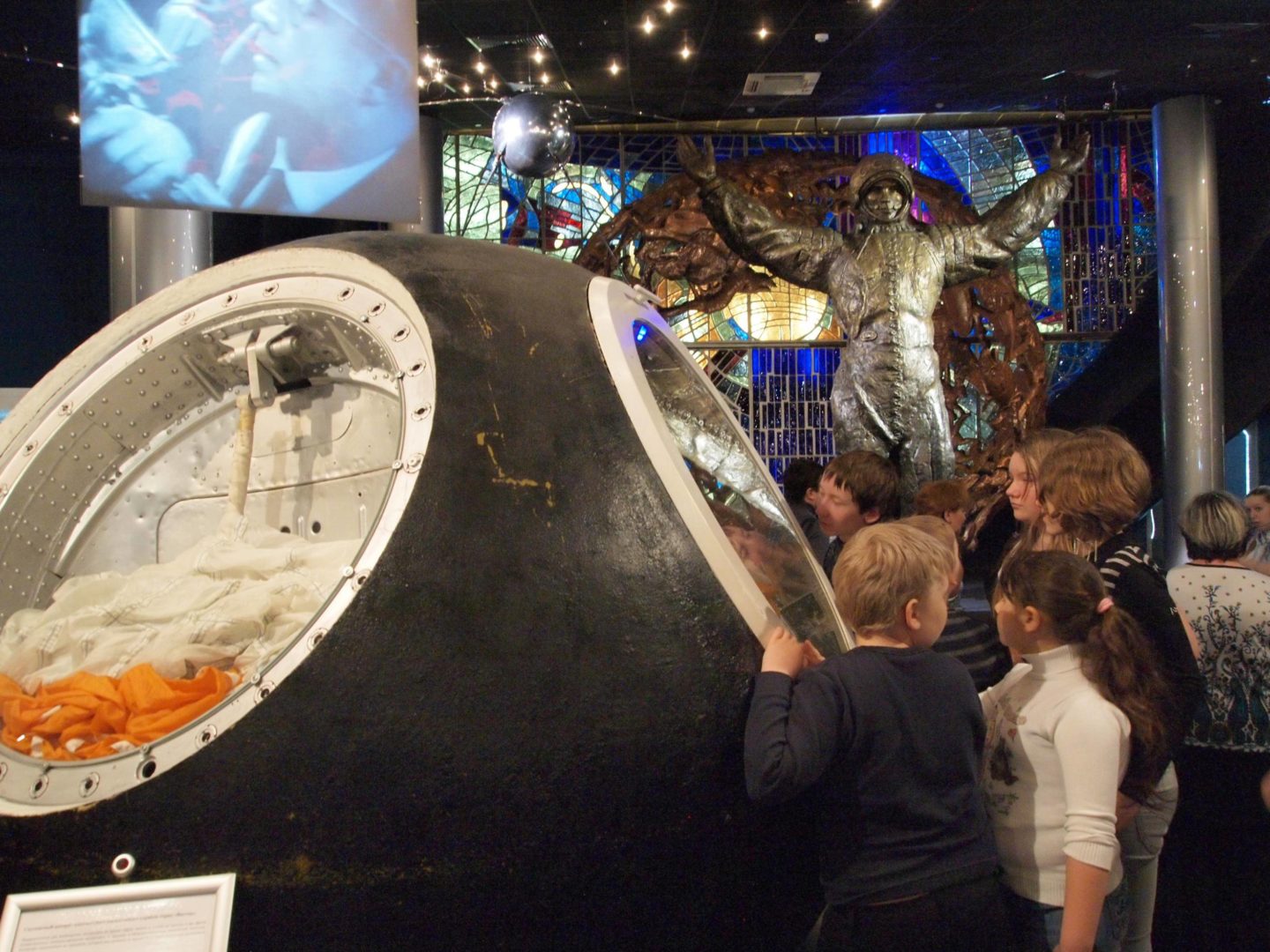 |
Soviet Sunday.

Going out alone. Trying the Metro. Public transport. Metro stations often are in the style of old soviet buildings. They are actually monuments on their own! The nearest station is Dynamo (Photo 22), alongside the large stadium of Dynamo Moscow. At the moment the stadium is undergoing large renovation work. It is still difficult to get used to that Russian script. I wrote down the Russian alphabet in my notebook. Also here, as in Japan, I have that feeling of a child that is just learning to read. There are quite a number of characters that are similar; however also many of them are very different. In that way I always thought that cccp is just cccp; however it is sssr. Practicing also here is the only solution to understanding. Learning to read again as a 59-year old. Never too old! I find out that CCCP is the abbreviation of Союз Советских Социалистических Республик (СССР); in our roman characters: Sojoez Sovjetskich Sotsialistitsjeskich Respoeblik (SSSR), translated: Union of Socialist Soviet Republics: USSR.
The Kremlin: Cathedrals and cannons
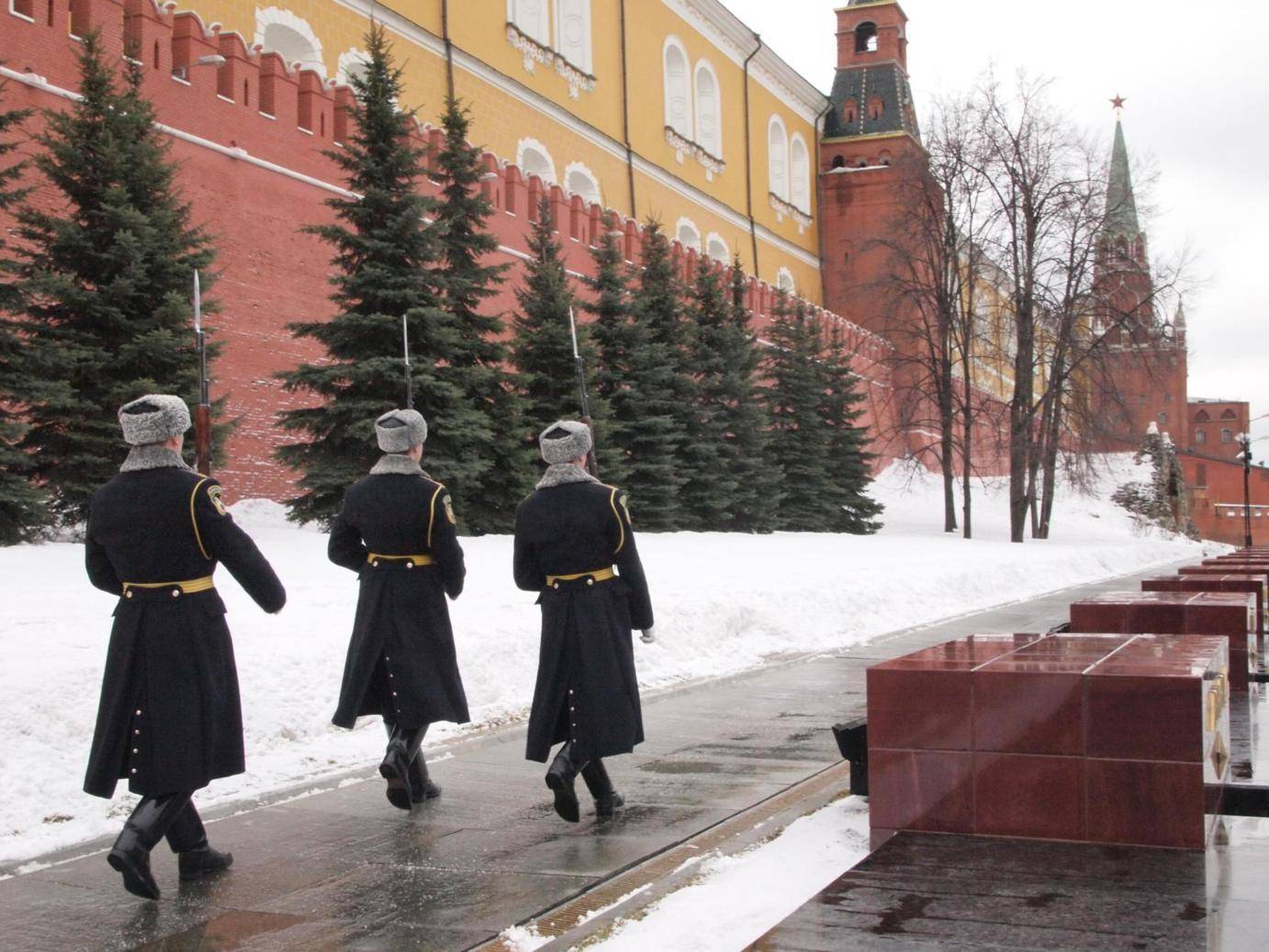
The Kremlin, the centre of power of Russia, for centuries. I walk through the gate of the Garden of Alexandrov. On the left side in front of the Kremlin wall: the monument of the unknown soldiers that died during the Second World War. The eternal flame with the ever-present guards honours them. I came at a good moment. A bit further I hear the sound of marching soldiers. In a strict rhythm a group of 3 is coming this way. I am virtually alone. And watch it. The pounding sound of the boots. The elegant but also intimidating movement of the right arm. The rifle pointing up straight, balancing on the palm of the left hand. The black boots reach up to breast-height. A commander walks along side and keeps control. They are marching to the platform with the eternal flame. For a moment they stand still. The rifle on the ground; the head facing the flame. It is quiet on the square. The rifles are picked up again and the soldiers, in the same marching mode, march to their colleagues, who each of them, came from their watch shelter. They are exchanged. The new soldiers take their position. The old group, again in the same tread, comes forward, salute the fire and march away. (Photo 23). Back to their barrack, a few hundred meters further. This ritual is repeated daily, every hour. A place where soldiers and their families can find rest. Where they get recognition for their deeds. Respect for those who died.
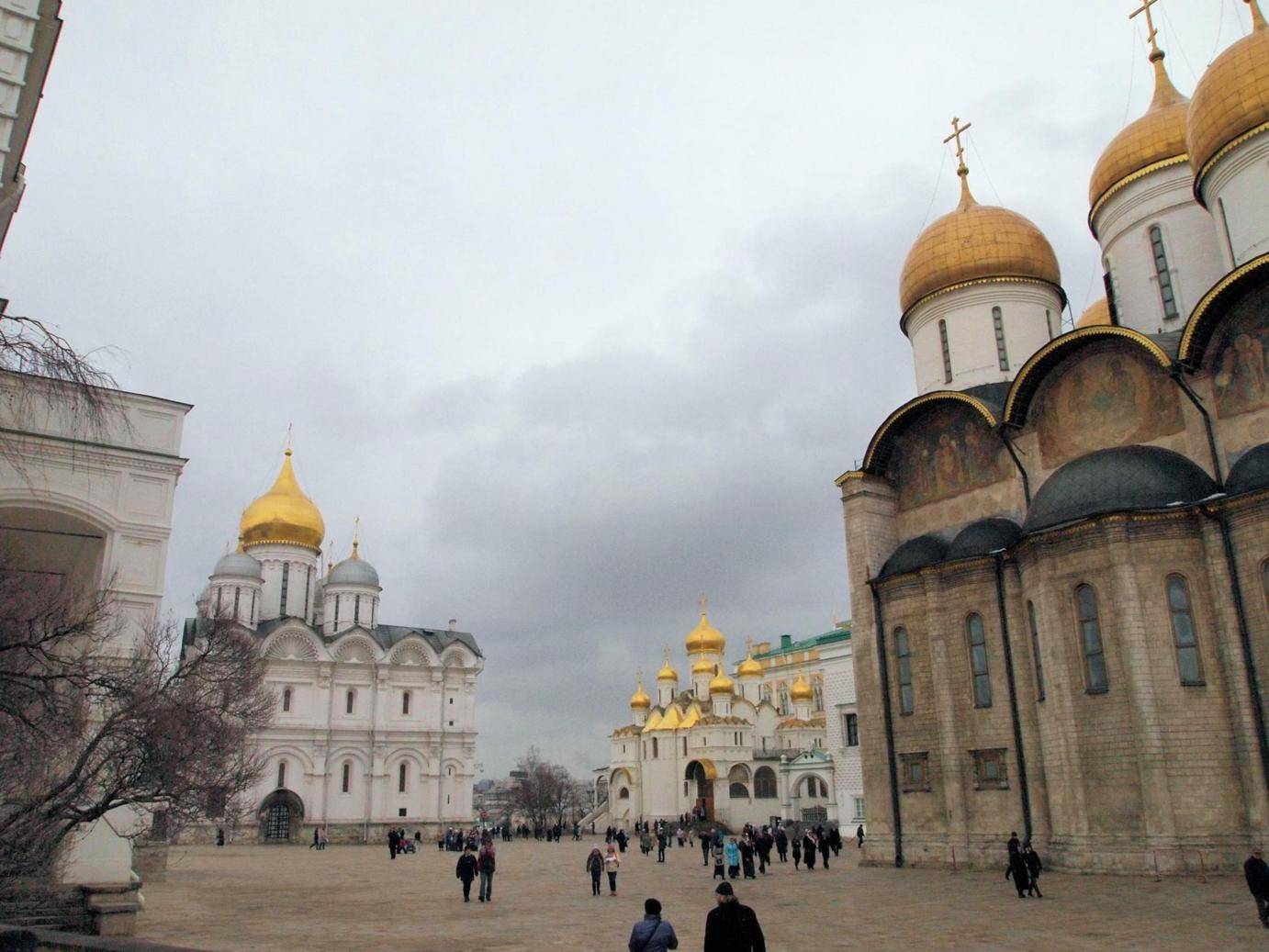
From here to the entrance of the Kremlin. Together with an English tourist that I met, I visit the Armoury: it is supposed to be the chamber of arms. However there is incredibly much more: Crowning jewels, gifts of great statesmen from the whole world. Incredible precious treasures; which each of them sealed a landmark of Russian history. The carriages, the arms, the mail armour, harnesses, the kings’ thrones. Tableware of the most precious material. Amazing craftsmanship of the great artists and craftsmen that worked on these objects! It is actually only since recent times that we as ordinary people get access to witness these treasures ourselves!
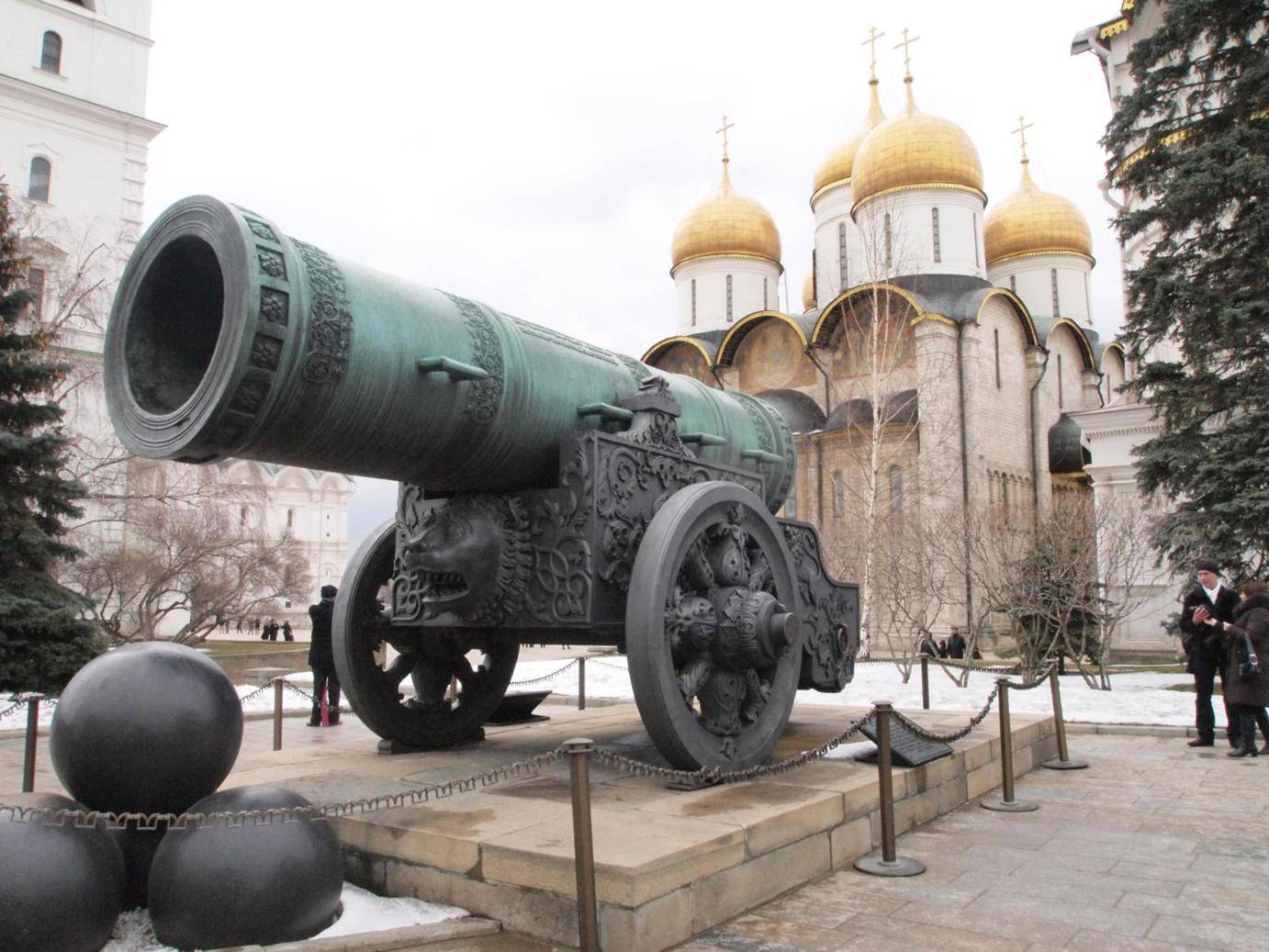
A bit further on the Kremlin we go to Cathedral Square (Photo 24). The Archangel’s Cathedral (1508), the Cathedral of the Annunciation to the Mother of God (1489), the Cathedral of the Dormition (1479). The bell tower of Ivan the Great (1508). The 12 Apostles’ Church (1653). In front of it is the King of cannons: the Tsar-cannon (diameter of its barrel: 89 cm!) built in 1625 (Photo 25). Alongside of it the barrels of a whole range of smaller sizes. Cathedrals and Cannons. Religion and worldly power are intertwined inseparably.
Sterilising in Moscow
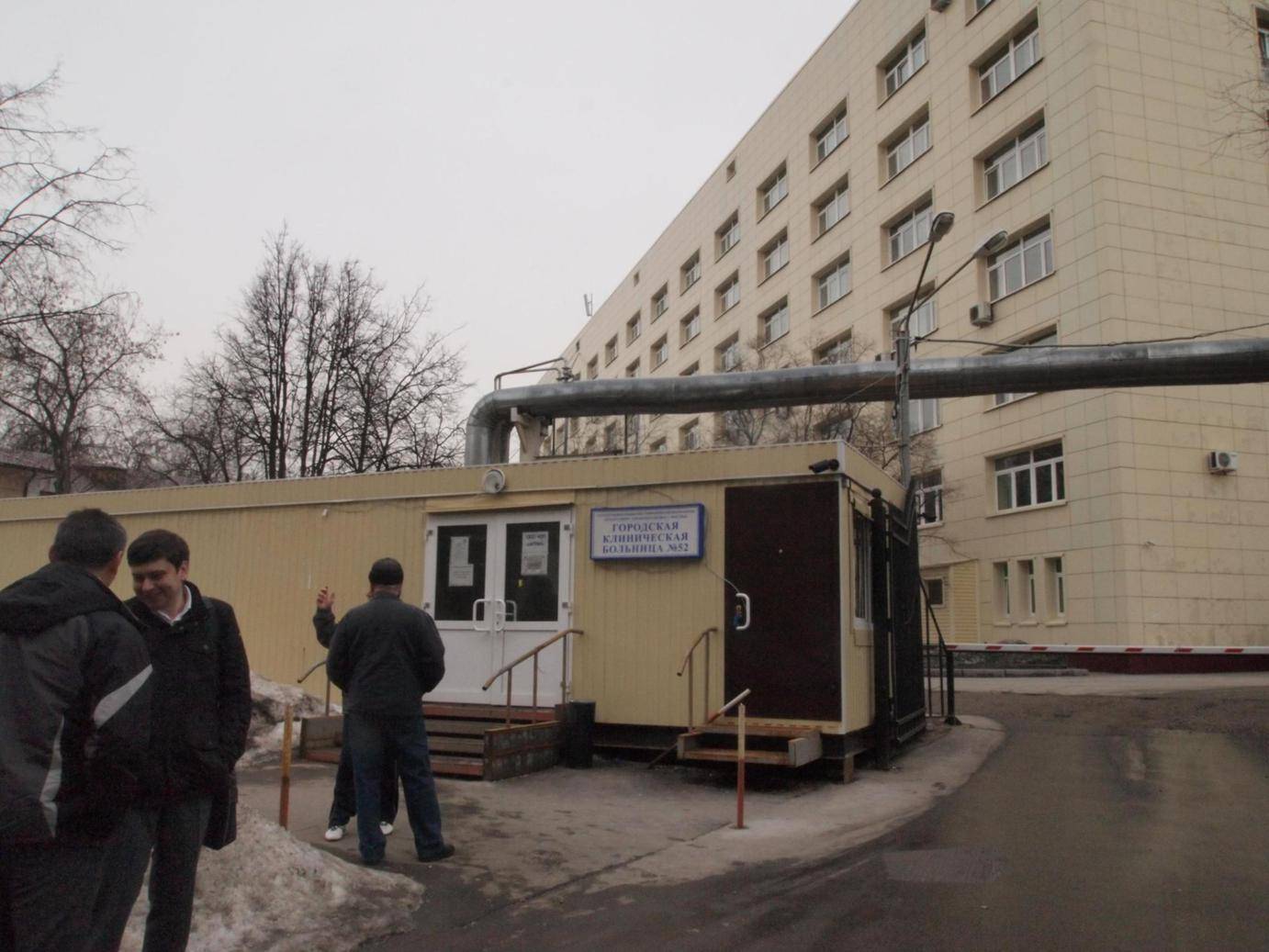 Being in Moscow I had an opportunity to visit some hospitals. Here they are marked by number. More basic it cannot be. The first one is nr. 52; later we visit Nr. 29 and Nr. 4. The entrance of the hospital 52 is as basic as its name. No large patient reception hall as in the health palaces as we are used to in the Netherlands. A very simple entrance building (Photo 26). Isolated warm water pipes are a kind of access gate. Ultimate basics. A hospital with 1500 beds. With 4 operating units, each having 7 theatres. In many buildings reconstruction is going on.
Being in Moscow I had an opportunity to visit some hospitals. Here they are marked by number. More basic it cannot be. The first one is nr. 52; later we visit Nr. 29 and Nr. 4. The entrance of the hospital 52 is as basic as its name. No large patient reception hall as in the health palaces as we are used to in the Netherlands. A very simple entrance building (Photo 26). Isolated warm water pipes are a kind of access gate. Ultimate basics. A hospital with 1500 beds. With 4 operating units, each having 7 theatres. In many buildings reconstruction is going on.
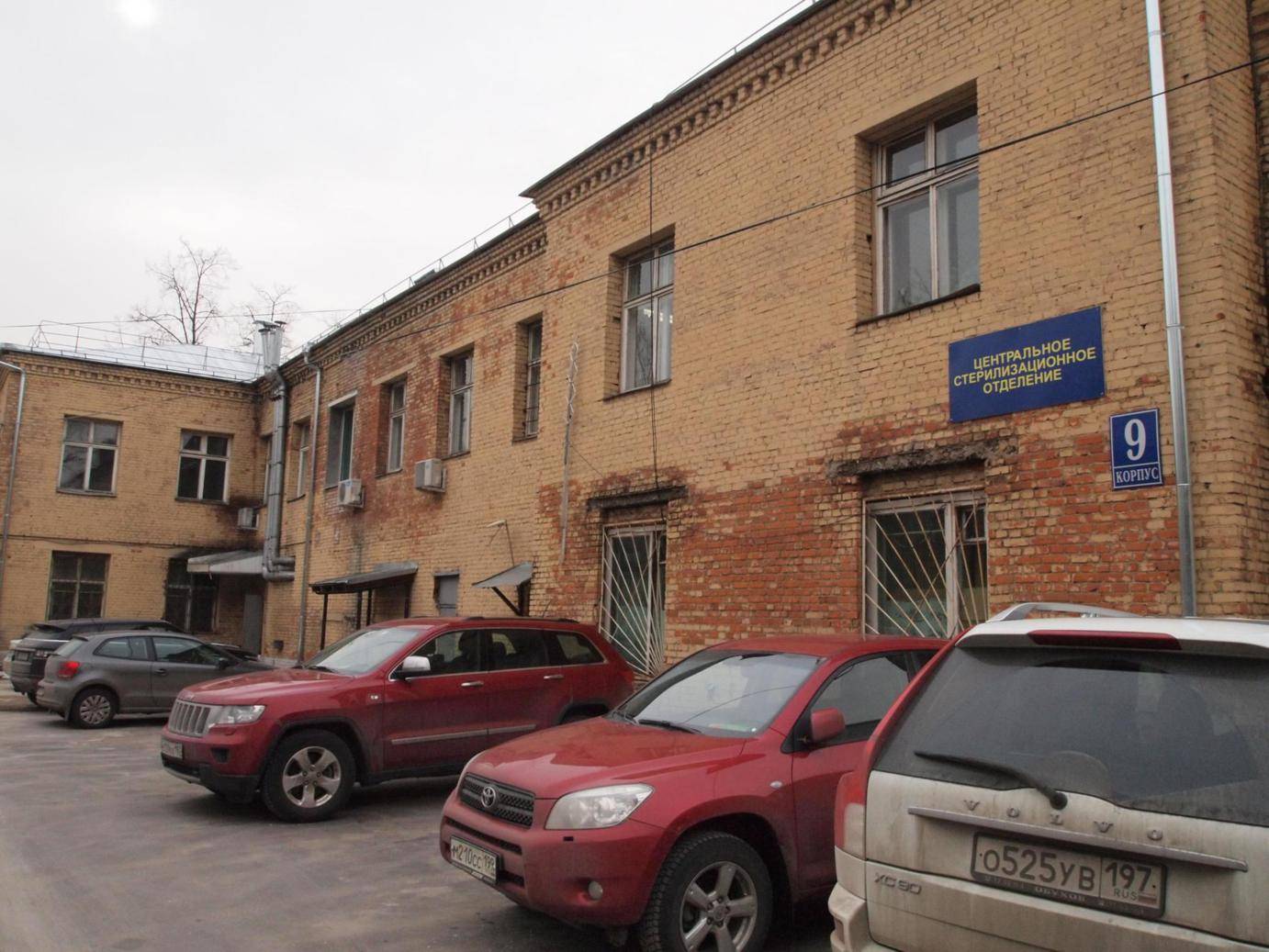
The sterilization department (Photo 27) is a somewhat old, tired building. The iron door. We are welcomed by Nelly, head of the department. She shows her department. We are shown all steps of the reprocessing cycle. This hospital is equipped with modern, double door washer disinfectors and 4 large double-door autoclaves of which 3 are currently used. Each of them 7 cycles per day. Unfortunately we come on the wrong moment. All instrument sets that were processed this morning are gone out already. The new dirty sets need to come yet. A big pity. The instrument sets are disinfected in the OR and are delivered in containers here at the CSSD.

The instrument trays that are still here look tired. Due to years of intensive use. Packaging is done in crepe paper, paper bags, peel pouches, cotton and Schimmelbush drums (Photo 28). On the packs a label is attached made of a kind of canvas; the sterilization history is written by ballpoint. However there is no autoclave tape. Before autoclaving an indicator sticker is put on textile packs and after sterilization it is pasted into the autoclave’s logbook. Lots of writing work, checks, as part of quality insurance. All needs to be done manually.
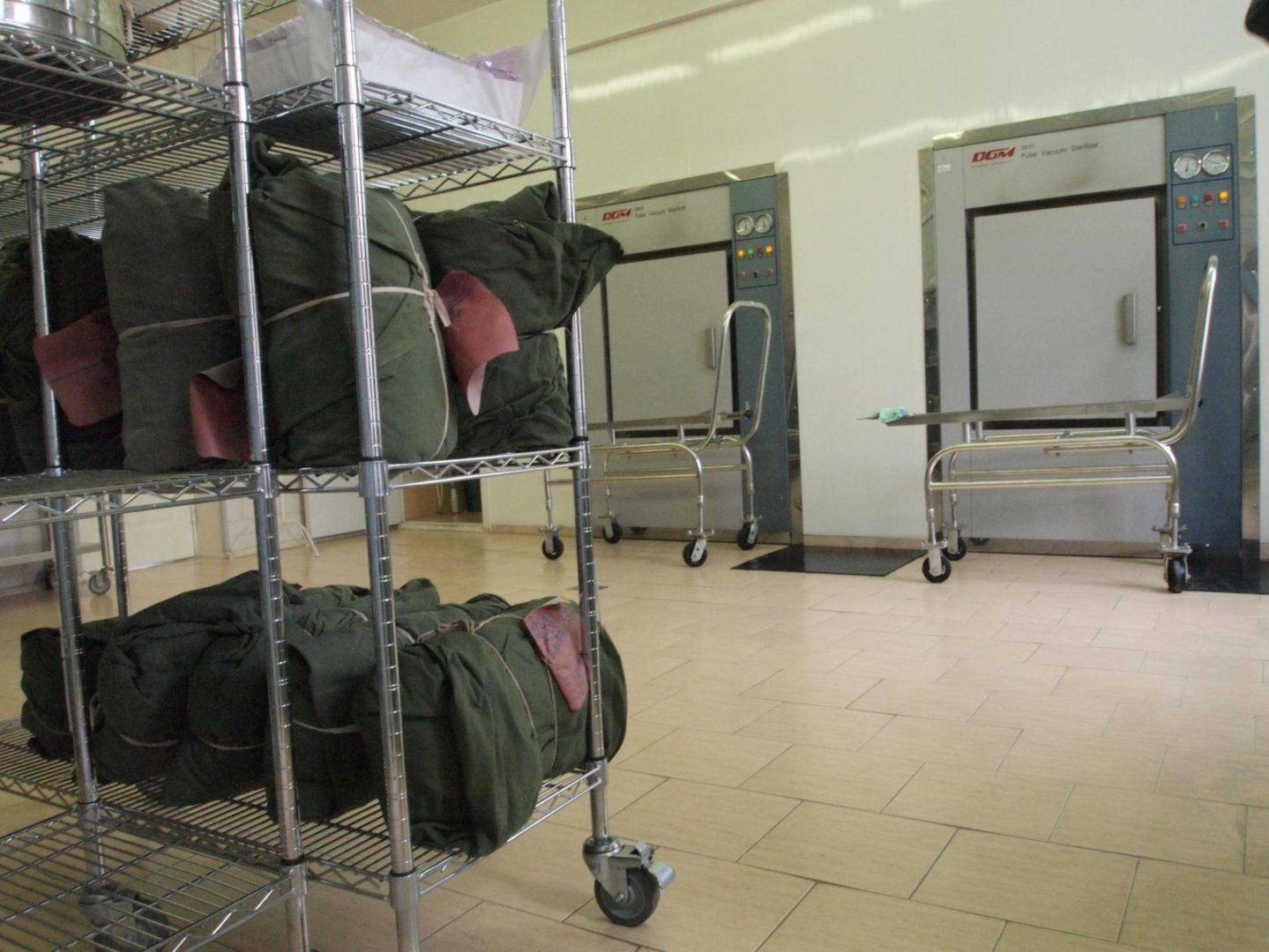
However sterilizing is done in state-of-the-art 600 litre double-door sterilizers (Photo 29). The sterile store is rather small. Virtually all instrument sets are in circulation. Through a counter in the storage area the packs are delivered in bags and distributed to the rest of the hospital departments. The staff canteen is like a cosy living room. With flowers and plants. We drink a cup of coffee with Russian chocolates. The tin with Dutch stroopwaffels she wants to keep for the break time, and eat together with her staff. The farewell from Nelly. So courageous to run the department! When leaving the department I embrace her. Thank her for her dedication and for everybody that tries their very best to do a good job.
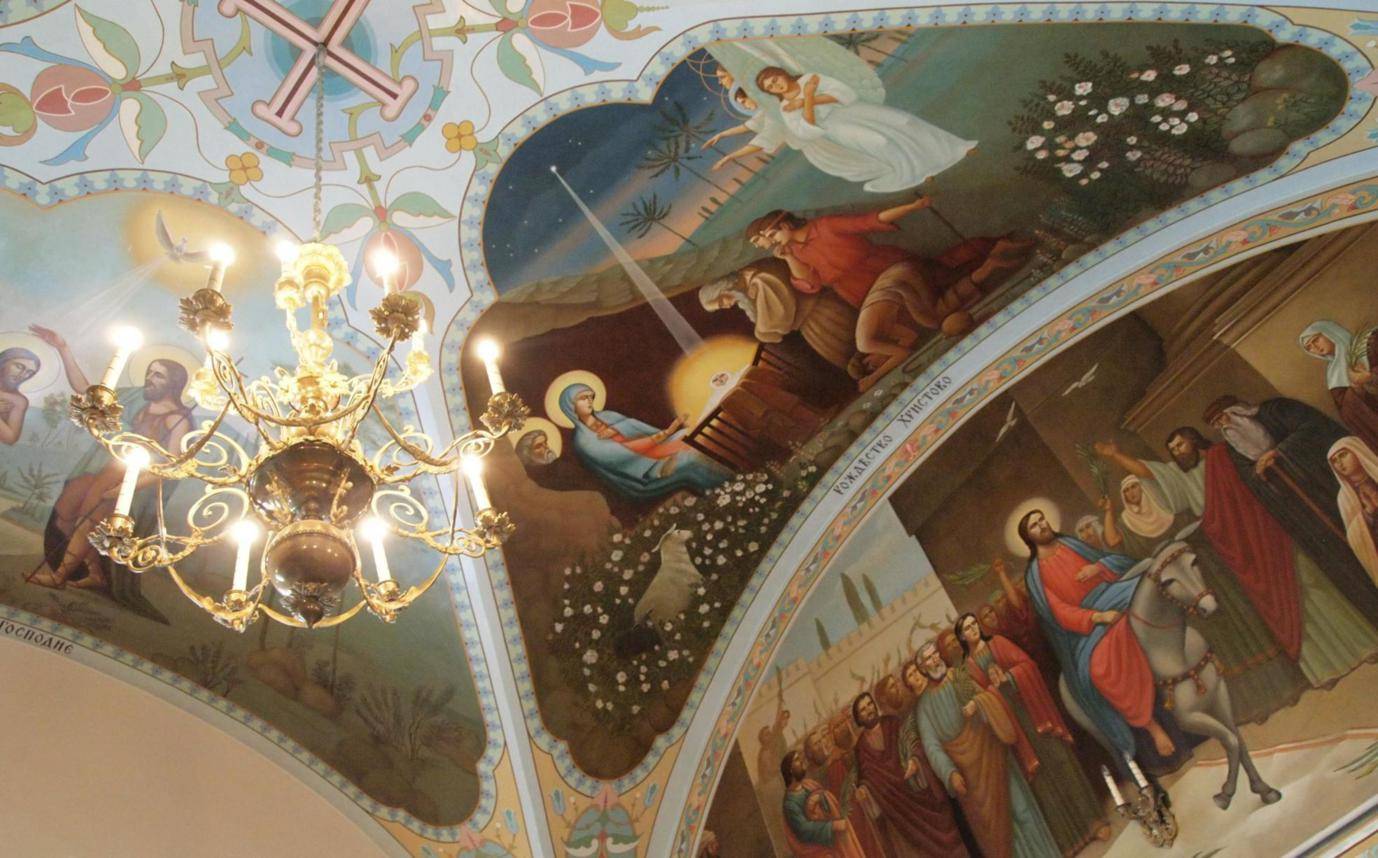
Hospital 29, that we visit later, is dedicated to the Virgin Mary. After the end of the Soviet era, religion was allowed to get a place in society again and churches and other religious symbols were reinstated in large numbers. The chapel of the hospital can be recognized from far away from its golden dome with the cross. We go inside. An elderly woman is caring for the candle stands; her small shop. I gaze up. The chandelier; the bright, colourful frescos with images of the birth of Christ (Photo 30).
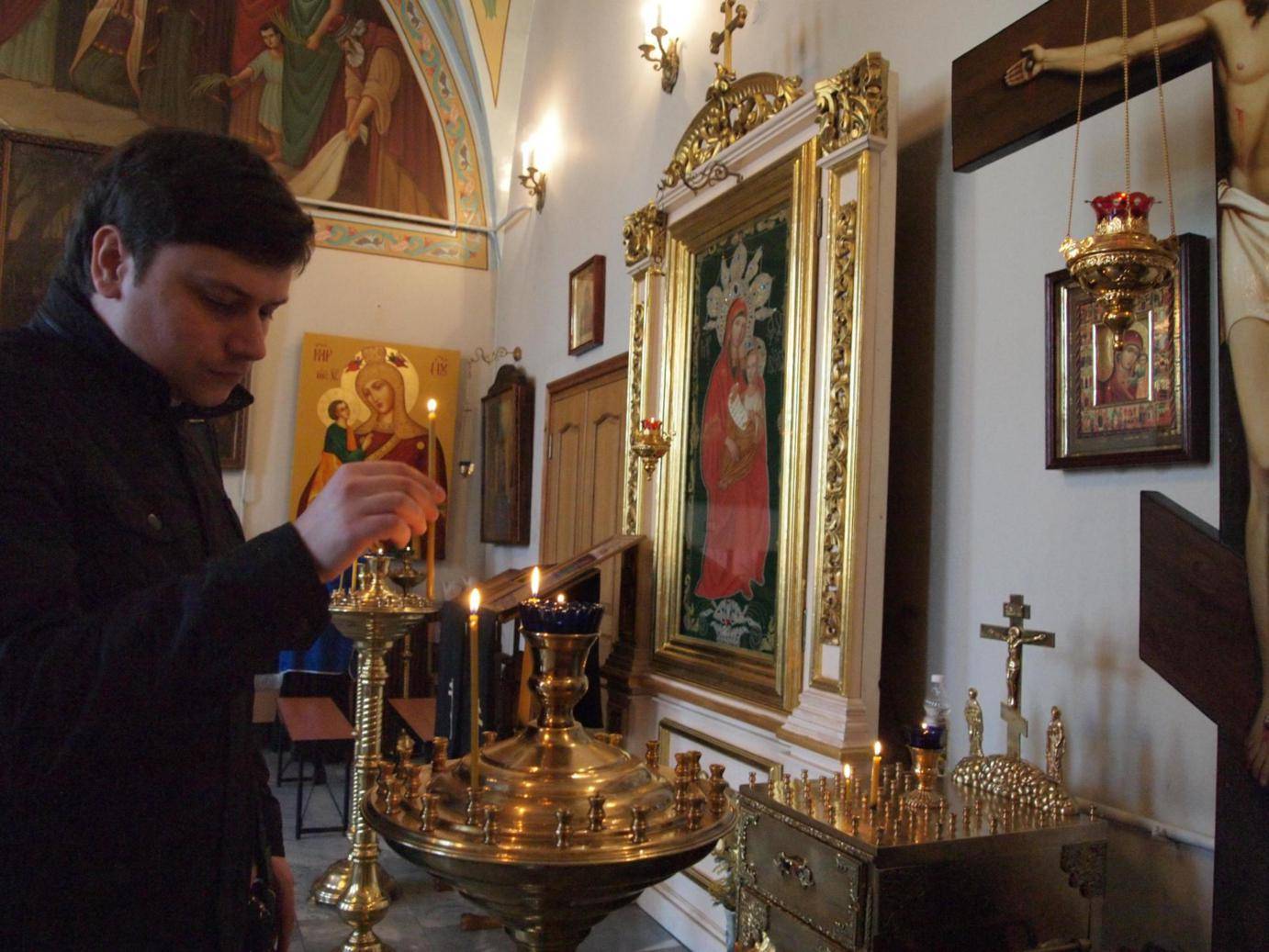 |
The person accompanying us during our visit, Pavel, lights candles in front of the cross. And stands quiet for a moment. Eyes closed. Throughts travel. (Photo 31). Feel the reverence for the place. A place of consolation, a place of inner tranquillity. Of searching for peace inside oneself. |
Goodbye to the USSR
Monday April 8. The last stop before departure in the Office of PharmStandard/DGM. A meeting with Elena and Vladimir (during soviet times he worked as an officer in an atomic submarine(!). We discus the business side of the visit; the settling of finances. There are possibilities for the future! A second print of the book; possible training. A final cup of coffee. Also here the farewell. The embracing; thank for all that I could receive, experience, see!

Now, April 9th on the airport. I am writing the last words of this mail. I am checked in. The plane is ready. A few moments later the roaring engines. Take off; and I see the gigantic city of Moscow drifting away in the east (Photo 32). Already the mind travels to the return of Yoko, my wife, who will return on Thursday after a 3 months travel to Asia!
From Russia, with Love, Jan Huijs
